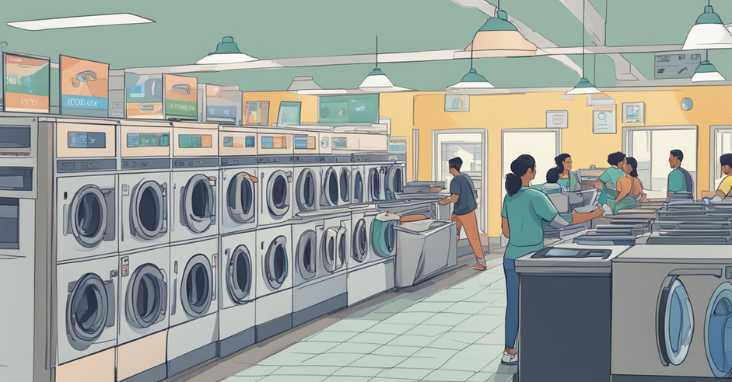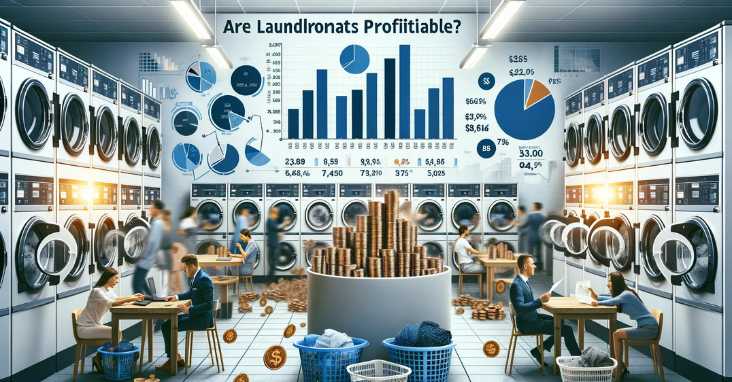Are laundromats profitable ? Yes, laundromats can be profitable with steady demand, low labor costs, and strategic location. Key to success: efficient operations and maintenance.
Laundromats have been a popular business model for decades, providing a convenient solution for people to clean their clothes without the hassle of owning a washing machine. However, thequestion of are laundromats profitable has been a topic of debate among entrepreneurs and investors. Some argue that it is a low-margin business with high operational costs, while others claim that it can be a lucrative investment with the right strategy.

Understanding the Laundromat Business is crucial to determining its profitability. The industry is highly competitive, and success depends on various factors such as location, equipment, and customer service. Laundromats require significant upfront investment in equipment and rent, and maintenance costs can add up quickly. Operational Considerations such as staffing, inventory management, and marketing also play a significant role in determining profitability.
Key Takeaways
- Location is a crucial factor in determining the profitability of a laundromat.
- Effective marketing and customer retention strategies can increase revenue and profitability.
- Additional revenue opportunities such as vending machines and drop-off services can also contribute to the success of a laundromat business.
Understanding the Laundromat Business
Laundromats are a type of self-service laundry business that provides washing and drying machines to customers for a fee. The laundromat business has been around for many years and has evolved over time to meet the changing needs of customers. In this section, we will explore the key components of a laundromat, the laundromat industry overview, and the pros and cons of owning a laundromat.
Key Components of a Laundromat
A typical laundromat business consists of the following key components:
Washing Machines: These are the main components of a laundromat. They come in various sizes and types, including top-loading, front-loading, and high-capacity machines.
Drying Machines: These machines are used to dry clothes after washing. Like washing machines, they come in various sizes and types.
Payment Systems: Laundromats usually have coin-operated machines, but some also accept credit and debit cards or mobile payments.
Maintenance: Laundromats require regular maintenance to keep the machines in good working condition. This includes cleaning the machines, replacing broken parts, and fixing any issues that arise.
Laundromat Industry Overview
The laundromat industry is a part of the larger laundry business, which includes dry cleaners, commercial laundry services, and home laundry services. According to the Coin Laundry Association, there are approximately 30,000 laundromats in the United States, generating an estimated $5 billion in revenue annually.
The laundromat business is considered a small business and can be an attractive option for entrepreneurs looking to start their own business. However, like any business, it has its own set of challenges.
Pros and Cons of Owning a Laundromat
Owning a laundromat has its pros and cons. Some of the pros include:
Recurring Revenue: Laundromats generate recurring revenue, as customers need to wash and dry their clothes regularly.
Low Overhead Costs: Laundromats have relatively low overhead costs compared to other businesses, as they do not require a lot of inventory or staff.
Flexible Schedule: Laundromat owners have a flexible schedule and can choose when to open and close their business.
Some of the cons of owning a laundromat include:
Maintenance Costs: Laundromats require regular maintenance, which can be costly.
Competition: The laundromat business is highly competitive, and owners need to differentiate themselves from their competitors to attract customers.
Customer Behavior: Some customers may abuse the machines or use them improperly, leading to costly repairs or replacements.
Overall, owning a laundromat can be a profitable business if done correctly. However, it requires careful planning, management, and maintenance to be successful.
Here is a link to the Coin Laundry Association website, which provides more information about the laundromat business and industry.
Financial Aspects of Laundromats
Are laundromats profitable business ventures, but it’s important to understand the financial aspects involved before investing in one. This section will cover the start-up costs, revenue streams, profit margins, break-even analysis, and return on investment (ROI) associated with laundromats.
Start-Up Costs and Initial Investment
The start-up costs for a laundromat can vary depending on the location, size, and equipment needed. According to The Balance Small Business, the average cost to open a laundromat is between $200,000 and $500,000. This includes the cost of leasing or purchasing a space, buying equipment such as washers and dryers, and other expenses such as permits and licenses.
Revenue Streams and Profit Margins
Laundromats generate revenue through the use of their equipment and additional services such as vending machines and laundry supplies. The profit margins for laundromats can vary, but according to Laundry Solutions Company, the average gross margin for a laundromat is around 60%. This means that for every dollar earned, 60 cents goes towards covering expenses and the remaining 40 cents is profit.
Break-Even Analysis and ROI
A break-even analysis is an important tool for determining when are laundromats profitable. This analysis takes into account the start-up costs, ongoing expenses, and revenue streams to determine how many customers are needed to break even. According to Entrepreneur, the average break-even point for a laundromat is around 18 months.
The ROI for a laundromat can also vary depending on the initial investment and ongoing expenses. According to Small Business Trends, the average ROI for a laundromat is around 20% to 30%.
In conclusion to the question are laundromats profitable business ventures, with the right financial planning and management. It’s important to consider the initial investment, revenue streams, profit margins, break-even analysis, and ROI before investing in a laundromat.
Operational Considerations

Equipment and Maintenance
Laundromats require a significant amount of equipment to operate, including washers, dryers, folding tables, and more. The initial cost of purchasing and installing this equipment can be high, but it is important to invest in high-quality, reliable machines to minimize maintenance costs in the long run. Regular maintenance and repairs are necessary to ensure that equipment is functioning properly and to prevent breakdowns that could result in lost revenue. It is recommended to schedule routine maintenance checks and keep a detailed record of all repairs and replacements.
According to The Spruce, top-loading washers are generally less expensive to purchase and maintain than front-loading washers, but they are less efficient and use more water. Front-loading washers are more expensive but offer greater energy efficiency and water savings in the long run.
Utility Costs and Efficiency
Utility costs, including water, gas, and electricity, can be a significant expense for laundromats. It is important to choose energy-efficient equipment and to implement practices that reduce water and energy usage. This can include installing low-flow faucets and toilets and using high-efficiency lighting. It is also important to monitor utility bills and make adjustments as needed to reduce costs.
According to Coin Laundry Association, laundromats can save significant amounts of money by using high-efficiency equipment and implementing water-saving measures. For example, replacing older top-loading washers with new, high-efficiency models can reduce water usage by up to 50%.
Staffing and Daily Operations
Laundromats require a certain amount of staffing to operate effectively. This can include attendants to assist customers, perform routine maintenance tasks, and handle cash transactions. It is important to hire reliable, trustworthy employees and to provide adequate training to ensure that they are able to perform their duties effectively.
Daily operations can include tasks such as cleaning, restocking supplies, and handling customer complaints or issues. It is important to establish clear policies and procedures for these tasks and to ensure that they are consistently followed.
According to Entrepreneur, laundromats can be operated with minimal staffing, but it is important to ensure that employees are available during peak hours to assist customers and maintain equipment. It is also important to establish clear policies and procedures for handling cash and other financial transactions to prevent theft or fraud.
Location and Market Analysis

Choosing the Right Location
When it comes to opening a laundromat, location is key. The success of the business largely depends on the location of the store. A good location is one that is easily accessible and visible to potential customers. A laundromat located in a residential area with high foot traffic is likely to be more profitable than one located in a commercial area with low foot traffic. It is important to consider factors such as parking availability, proximity to public transportation, and the overall safety of the area when choosing a location.
Understanding Your Customer Base
To run a profitable laundromat, it is important to understand the customer base. The target market for laundromats is typically individuals who do not have access to a washer and dryer in their homes or apartments. It is important to consider the demographics of the area when choosing a location, as this can help determine the needs and preferences of potential customers. For example, a laundromat located in a college town may have a higher demand for larger machines to accommodate the needs of students.
Competition and Market Size
Before opening a laundromat, it is important to research the competition in the area. This includes not only other laundromats but also any other businesses that offer laundry services, such as dry cleaners. Understanding the market size and demand for laundry services in the area can help determine the potential profitability of the business. It is important to consider the needs of the community and any gaps in laundry services that the business can fill.
According to a study by the Coin Laundry Association, the self-service laundry industry is a $5 billion industry in the United States alone. This demonstrates the potential for profitability in the industry. However, it is important to thoroughly research the market and competition in the area before opening a laundromat.
As stated by Entrepreneur, “A good location, a solid business plan and access to capital are all essential components to a successful laundromat.” By carefully considering the location, customer base, and competition in the area, a laundromat owner can increase the chances of running a profitable business.
Marketing and Customer Retention
Laundromats face tough competition in the laundry industry, and effective marketing strategies are essential to attract and retain customers. In addition, enhancing customer experience and offering loyalty programs and community engagement initiatives can help to retain customers and increase profits.
Effective Marketing Strategies
Marketing strategies are critical to attracting new customers and retaining existing ones. Laundromats can use various tactics to market their services, such as social media advertising, email marketing, and local advertising. Social media is an effective tool to reach a broader audience and promote special offers and discounts. Email marketing can also be useful to keep customers informed about new services and promotions.
Local advertising is another effective marketing strategy for laundromats. Placing ads in local newspapers, distributing flyers, and posting signs in the neighborhood can help to attract new customers. Additionally, participating in local community events and partnering with other local businesses can also help to increase visibility and attract new customers.
Enhancing Customer Experience
Laundromats can enhance customer experience by offering additional services such as drop-off and pick-up laundry services, vending machines, and free Wi-Fi. Providing comfortable seating and entertainment options such as televisions and magazines can also make the laundry experience more enjoyable for customers.
In addition, excellent customer service is essential to retain customers and attract new ones. Laundromats should ensure that their staff is friendly, knowledgeable, and responsive to customer needs. Providing prompt and efficient service and addressing customer complaints promptly can help to build customer loyalty.
Loyalty Programs and Community Engagement
Loyalty programs and community engagement initiatives can also help to retain customers and increase profits. Laundromats can offer loyalty programs that reward customers for their continued business, such as discounts, free services, or exclusive promotions. Additionally, partnering with local charities and community organizations can help to build goodwill and attract new customers.
Laundromats can also organize community events such as charity drives, open houses, or customer appreciation days to engage with the local community and build relationships with customers. By building strong relationships with customers and the community, laundromats can increase customer loyalty and attract new customers through word-of-mouth advertising.
In conclusion, effective marketing strategies, enhancing customer experience, and loyalty programs and community engagement initiatives are critical to the success of laundromats. By implementing these strategies, laundromats can attract and retain customers, increase profits, and build a strong reputation in the community.
Here is a resource with more information on marketing and customer retention strategies to answer the question of are laundromats profitable.
Additional Revenue Opportunities

Laundromats have a lot of potential for generating additional revenue beyond just the use of washers and dryers. Here are a few options for laundromat owners to consider:
Vending Machines and Ancillary Services
One way to generate additional revenue is through vending machines and ancillary services. These can include snacks, drinks, fabric softener, and even an ATM machine. By offering these amenities, laundromats can provide customers with convenience and comfort while they wait for their laundry to finish.
According to Coin Laundry Association, 90% of laundromats have vending machines, and 60% have an ATM. Adding these services can increase the likelihood of customers choosing your laundromat over others in the area.
Wash-and-Fold and Dry Cleaning Services
Offering wash-and-fold and dry cleaning services can also be a great way to generate additional revenue. Many customers prefer to have their laundry done for them, and by offering these services, laundromats can cater to those customers.
Laundromats can partner with a local dry cleaner to offer these services, or they can invest in the necessary equipment and staff to provide them in-house. According to Entrepreneur, wash-and-fold services can generate up to $150,000 in annual revenue.
Innovative Laundromat Services
Laundromats can also generate additional revenue by offering innovative services that set them apart from competitors. These can include entertainment options like televisions or free Wi-Fi, or even ironing services.
One example of an innovative laundromat service is The Laundry Cafe, a laundromat that also serves coffee and food. By offering a unique experience, The Laundry Cafe has been able to attract a loyal customer base.
By offering additional revenue opportunities like vending machines, wash-and-fold services, and innovative services, laundromats can increase their profitability and attract more customers.
Legal and Regulatory Considerations

Licenses and Permits
Operating a laundromat requires obtaining certain licenses and permits to comply with local, state, and federal regulations. These regulations vary depending on the location of the laundromat and the services offered. For example, some states require a business license and sales tax permit, while others require a specific permit for air emissions from dryers.
Before opening a laundromat, it is important to research the specific licenses and permits required in the area. The Small Business Administration provides a helpful resource to find the necessary licenses and permits by state and industry.
Health and Safety Regulations
Laundromats must also comply with health and safety regulations to ensure the well-being of customers and employees. These regulations include proper sanitation, fire safety, and adequate ventilation.
The Occupational Safety and Health Administration (OSHA) provides guidelines for laundromat safety, including the handling of hazardous chemicals and proper machine maintenance. It is important to regularly train employees on these guidelines to ensure compliance and prevent accidents.
Additionally, laundromats must adhere to local health codes and regulations. The Centers for Disease Control and Prevention provides resources for laundromat owners to prevent the spread of infectious diseases.
In conclusion, obtaining the necessary licenses and permits and complying with health and safety regulations are crucial for the success and sustainability of a laundromat. By staying up-to-date on these regulations and guidelines, laundromat owners can ensure a safe and profitable business.
Source: Small Business Administration
Financing and Investment

Financing Options for Laundromats
Starting a laundromat business requires a significant amount of capital investment. Entrepreneurs who do not have enough savings to fund the business can apply for financing options. Financing options for laundromats include traditional bank loans, Small Business Administration (SBA) loans, and equipment financing. Traditional bank loans offer competitive interest rates and terms, but they require a high credit score and a substantial down payment. SBA loans are government-backed loans that offer flexible terms and low-interest rates. Equipment financing is another option that allows entrepreneurs to purchase equipment with a low down payment and flexible terms.
Investing in an Existing Laundromat
Investing in an existing laundromat can be a profitable venture. Entrepreneurs can either buy an existing laundromat or purchase a share in a partnership. Buying an existing laundromat requires a considerable amount of capital investment, but it comes with an established customer base and a proven track record. Investing in a partnership allows entrepreneurs to share the risks and rewards of the business with other investors.
Partnerships and Investors
Partnerships and investors can help entrepreneurs finance their laundromat business. Partnerships allow entrepreneurs to share the risks and rewards of the business with other investors. Investors can provide capital investment in exchange for a share in the profits. Entrepreneurs should carefully consider their options and choose partners or investors who share their vision and have a similar level of commitment.
Entrepreneurs who are interested in starting a laundromat business should carefully consider their financing and investment options. They should research the different financing options available and choose the one that best suits their needs. They should also consider investing in an existing laundromat or partnering with other investors to share the risks and rewards of the business. For more information on financing and investment options for laundromats, entrepreneurs can visit the Small Business Administration website.
Future of Laundromat Businesses

As the laundromat industry continues to evolve, there are several emerging trends and innovations that are expected to shape the future of this business. In this section, we will explore some of these trends and examine how they might impact the profitability of laundromats in the years to come.
Trends and Innovations
One of the most significant trends in the laundromat industry is the increasing use of technology to improve the customer experience. For example, many laundromats now offer mobile payment options, allowing customers to pay for their laundry using their smartphones. Additionally, some laundromats are experimenting with new technologies such as smart machines that can detect when a load is finished and send a notification to the customer’s phone.
Another trend that is likely to impact the future of laundromat businesses is the growing demand for eco-friendly and sustainable practices. As consumers become more conscious of their environmental impact, they are increasingly seeking out businesses that prioritize sustainability. Laundromats can capitalize on this trend by adopting eco-friendly practices such as using energy-efficient machines and offering reusable laundry bags.
Sustainability and Eco-Friendly Practices
In addition to being a growing consumer trend, sustainability and eco-friendliness can also be a source of cost savings for laundromat businesses. For example, using energy-efficient machines can help reduce utility bills, while offering reusable laundry bags can reduce the cost of purchasing disposable bags.
Laundromats that prioritize sustainability and eco-friendliness can also benefit from positive word-of-mouth marketing. As more consumers become aware of the impact their choices have on the environment, they are more likely to seek out businesses that share their values. By promoting their eco-friendly practices, laundromats can attract new customers and boost their success rate.
Overall, the future of laundromat businesses looks bright, with many opportunities for growth and innovation. By staying flexible and adapting to emerging trends, laundromat owners can position themselves as recession-resistant and recession-proof businesses that are well-suited to thrive in the years to come.
Here is a link to an external resource with more information on laundry industry trends to help answer the question, are laundromats profitable.
Conclusion

In conclusion, the profitability of a laundromat largely depends on various factors such as the utilization rate, turnover, and recurring costs. While there is a steady demand for laundry services, it is important to consider the competition in the area and the forecast for future demand.
One of the advantages of owning a laundromat is the recurring revenue generated from repeat customers. However, it is important to maintain a high utilization rate to maximize profits. This can be achieved by having well-maintained machines, offering additional services such as dry cleaning, and providing a comfortable and clean environment for customers.
It is also important to consider recurring costs such as rent, utilities, and maintenance. These costs can vary depending on the location and size of the laundromat. Owners should carefully analyze their expenses and find ways to reduce costs without sacrificing the quality of service.
According to a report by the Coin Laundry Association, the average laundromat generates $15,000 to $300,000 in annual gross revenue. However, this range can vary depending on the factors mentioned above.
Overall, owning a laundromat can be a profitable business if managed effectively. Owners should carefully consider all aspects of the business before investing and seek advice from industry experts. For more information on the profitability of laundromats, check out this resource from Entrepreneur.com.
Frequently Asked Questions

Are laundromats profitable annually?
The profitability of a laundromat can vary depending on several factors such as location, size of the business, and the number of machines available. According to a report by IBISWorld, the average annual profit for a laundromat in the United States is approximately $31,000. However, this figure can differ significantly depending on the specific circumstances of each business.
How much does it typically cost to start and operate a laundromat?
The cost of starting and operating a laundromat can vary widely depending on the location, size, and equipment needed. According to a report by Entrepreneur, the average cost to start a laundromat is between $200,000 and $500,000. This includes the cost of leasing or purchasing a space, purchasing equipment, and marketing the business. The ongoing operating costs include rent, utilities, maintenance, and employee salaries.
What are the common challenges faced by laundromat owners?
Laundromat owners may face several challenges, including competition from other laundromats, changing customer preferences, and equipment maintenance issues. In addition, laundromat owners may have to deal with the challenge of managing cash flow and ensuring that the business remains profitable.
How does one calculate the profitability of a laundromat?
The profitability of a laundromat can be calculated by subtracting the total operating expenses from the total revenue generated by the business. It is important to keep track of all expenses, including rent, utilities, employee salaries, and maintenance costs, to accurately calculate profitability.
What factors contribute to the success of a laundromat business?
Several factors can contribute to the success of a laundromat business, including the location of the business, the quality of equipment, and the level of customer service provided. In addition, offering additional services such as dry cleaning, folding, and delivery can help attract and retain customers.
How do laundromat revenues compare with the operational expenses?
Laundromat revenues can vary depending on the size of the business and the number of machines available. According to a report by the Coin Laundry Association, the average revenue per square foot for a laundromat is $1.25. However, it is important to keep in mind that operational expenses such as rent, utilities, and maintenance costs can significantly impact profitability.
For more information on the profitability of laundromats to answer the question are laundromats profitable, please refer to this article.















